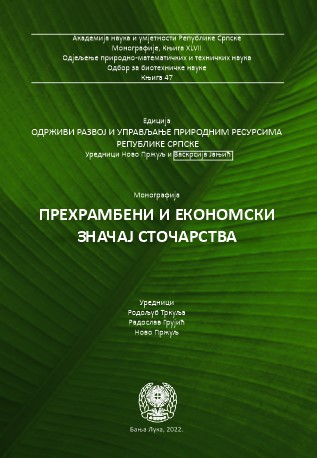Animal health
DOI:
https://doi.org/10.7251/EORU2204491TKeywords:
health, veterinary medicine, animals, prevention, treatmentAbstract
According to some definitions health is the absence of disease, thus it can be said that disease is the lack of health. However, it is difficult to agree with such a simplified approach, as health is not just a synonym for health status. The term health status has a much wider implication and it implies not only the state of health i.e. if the animals are healthy or not, but also is the herd is free from infectious diseases, and the implementation of biotechnological measures for the maintenance of productivity. It is possible that the animals have a poor health status (presence of latent infections) but are clinically healthy and productive. Similarly, it is possible that the animals are in a good health status, but the management, housing, care and diet are not adequate, resulting in the manifestation of clinical signs of disease. A disease is essentially the absence of health, i.e. a deviation from the harmonious functioning of some organs or organisms, which can then be clearly manifested through certain symptoms or signs, which is also called the clinical form of the disease. However, very often some diseases are present in a subclinical or latent form, when they can only be detected by one of the methods of serodiagnosis, but the best and safest way is by identifying the cause or by considering some parameters that indicate a decline in production. Health is a prerequisite for the profitability of keeping and raising animals. A healthy animal produces a healthy product that, after processing, becomes food for humans. In this way, human health is also protected. Animal proteins are an indispensable nutrient in the diet of the population. Unfortunately, animal health does not depend only on measures implemented in an area, country, or even a continent, but on a wider, global space and mode of transmission, most often of the causative agents of infectious diseases, which cause enormous damage to the economies of countries relaying on animal husbandry. Under the patronage of world organizations, the World Health Organization (WHO), the Food and Agriculture Organization (FAO) and the World Organization for Animal Health (OIE), of which almost all countries are members, universal rules and guidelines are being prepared and adopted for monitoring, detection, prevention of spreading, and control and eradication animal diseases. Each country adopts health care programs according to its potentials and accepts the obligation to report to world organizations, primarily to OIE, in the event of certain diseases of terrestrial and aquatic animals. Veterinary services have the greatest responsibility for animal health and food of animal origin, they have the role of public service in the protection of public health. Some countries have declared veterinary activity a common good, and the initiative is to define this service on a global scale. It is known that there are 1415 pathogens that cause infectious diseases in humans. Over 60% of human infectious diseases are of a zoonotic nature. At least 75% of emerging infectious diseases in humans are of animal origin. Every year, five new infectious diseases in humans appear, and most of them are of animal origin. Out of the pathogens with potential use for bioterrorist purposes, 80% of them are zoonotic pathogens. Disease prevention (preventive health care) will be a priority for veterinary and health systems and services in the future. In addition to the immunological measures that are being implemented (vaccination), epidemiological services have a wide range of options at their disposal that will become more important. Veterinary medicine works very effectively on the protection of farm breeding of various species of animals by prescribing the consistent application of health, zoohygiene and biosafety measures and procedures. In that way, the contact of the causative agent of the disease with the animal is prevented, which has proven to be the key factor in preventing the occurrence of mass diseases (epidemics, pandemics and other forms of infectious diseases).
